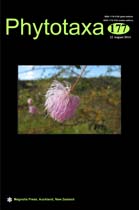Abstract
Hymenochaetaceae, belonging to Hymenochaetales and accommodating around 500 species, is one of the largest families in Basidiomycota (Kirk et al. 2008). Traditionally, poroid species in Hymenochaetaceae are mainly placed in Inonotus P. Karst. sensu lato and Phellinus Quél. sensu lato. To make a more natural taxonomic system, some small genera were segregated from the two large genera, and support for most of them was confirmed by later phylogenetic evidence (Wagner & Fischer 2002). Of the currently accepted genera, Fomitiporella Murrill, Fulvifomes Murrill and Phylloporia Murrill have species bearing non-stipitate basidiomes, no setae and colored basidiospores (Zhou & Dai 2012, Zhou 2014a, b). Several species in Inonotus sensu stricto also have these features. Therefore, it is hard to decide in which genus certain species should belong, based solely on morphological features. For this work, I performed phylogenetic analyses from nLSU and ITS sequences to explore the phylogenetic relationships of some species as discussed above, including Inonotus tenuissimus H.Y. Yu, C.L. Zhao & Y.C. Dai, Fomitiporella caryophylli (Racib.) T. Wagner & M. Fisch., Fulvifomes chinensis (Pilát) Y.C. Dai, Fulvifomes inermis (Ellis & Everh.) Y.C. Dai and Phylloporia resupinata Douanla-Meli & Ryvarden. Their taxonomic positions at generic level were also discussed considering morphology.

